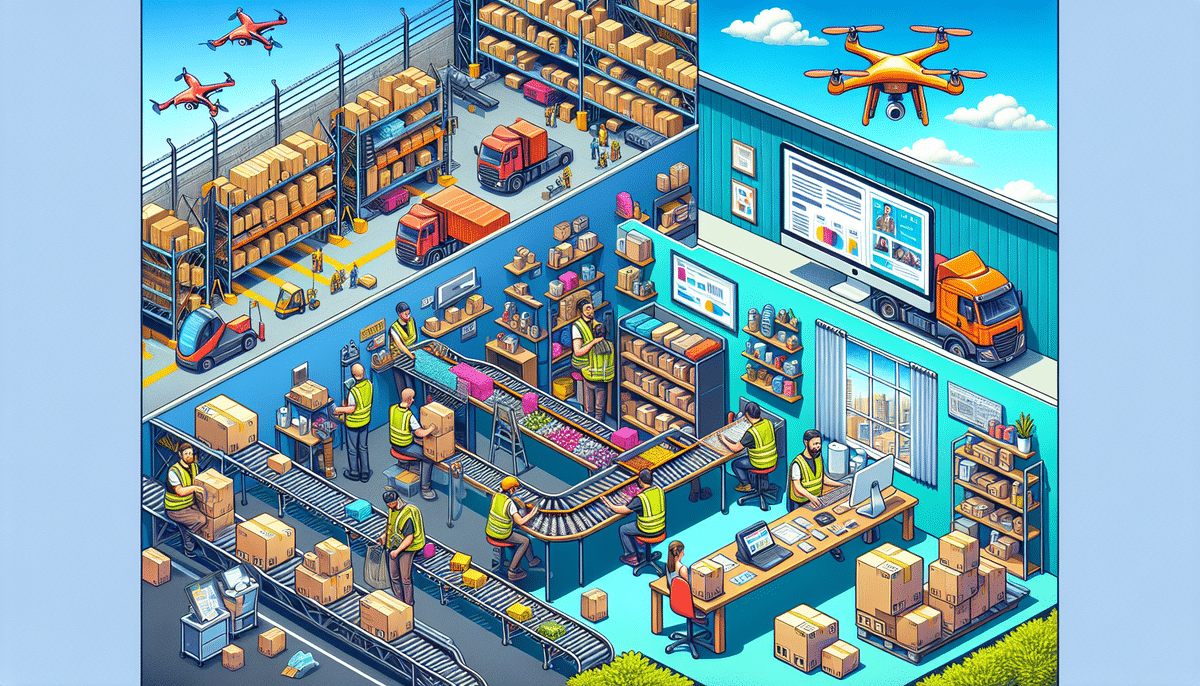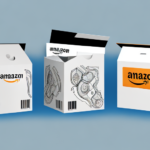Comparing Amazon FBA vs FBM: Which is the Better Option for Your Business?
Are you an Amazon seller wondering whether to use FBA (Fulfillment by Amazon) or FBM (Fulfillment by Merchant) for your business? In this article, we'll dive deep into the differences between FBA and FBM, providing detailed insights and data-driven analysis to help you decide which option aligns best with your business needs.
Table of Contents
- Understanding the Differences Between Amazon FBA and FBM
- What is Amazon FBA and How Does it Work?
- The Benefits of Using Amazon FBA for Your Business
- What is Amazon FBM and How Does it Work?
- The Advantages and Disadvantages of Using Amazon FBM
- Which Option is Best for Your Business Needs: FBA or FBM?
- Factors to Consider When Choosing Between FBA and FBM
- Cost Comparison: Is Amazon FBA or FBM More Affordable?
- Case Studies: Businesses That Have Thrived Using Amazon FBA vs FBM
- Tips for Making the Most of Your Amazon Fulfillment Option
- Future Trends in Amazon Fulfillment: What You Need to Know
- How to Switch Between Amazon Fulfillment Options
- Conclusion: Making the Right Choice for Your Business
Understanding the Differences Between Amazon FBA and FBM
Amazon offers two primary fulfillment options for sellers: FBA and FBM. Understanding these differences is crucial for optimizing your business strategy.
- FBA (Fulfillment by Amazon): You store your products in Amazon's fulfillment centers. Amazon handles storage, packaging, shipping, customer service, and returns.
- FBM (Fulfillment by Merchant): You store, pack, and ship your products directly to customers. Responsibility for customer service and returns lies with you.
Choosing between FBA and FBM depends on various factors, including your business size, product type, and operational capabilities.
What is Amazon FBA and How Does it Work?
Amazon FBA simplifies the fulfillment process by outsourcing storage, packaging, and shipping to Amazon. Here's how it works:
- Create an Amazon seller account and set up your FBA account.
- Send your inventory to Amazon's fulfillment centers.
- Amazon stores your products and manages inventory until a customer places an order.
- When an order is placed, Amazon picks, packs, ships the product, and handles customer service and returns.
As of 2023, over 60% of Amazon sellers utilize FBA to leverage Amazon's extensive logistics network and Prime eligibility (Source: Statista).
The Benefits of Using Amazon FBA for Your Business
FBA offers numerous advantages that can significantly enhance your business operations:
- Prime Eligibility: Products are eligible for Amazon Prime's free two-day shipping, increasing appeal to Prime members.
- Scalability: Easily scale your business without worrying about storage space or fulfillment logistics.
- Customer Service: Amazon handles customer inquiries, returns, and refunds, allowing you to focus on other aspects of your business.
- Global Reach: Access to Amazon's worldwide customer base can boost international sales.
- Discounted Shipping Rates: Benefit from Amazon's negotiated rates with carriers, potentially reducing shipping costs.
In 2023, sellers using FBA reported an average increase of 25% in sales compared to FBM (Forbes).
What is Amazon FBM and How Does it Work?
Amazon FBM requires you to manage the entire fulfillment process yourself. Here's how FBM operates:
- Create an Amazon seller account and list your products with detailed descriptions and competitive pricing.
- Store your inventory in your own facility or warehouse.
- When an order is placed, you handle packing and shipping directly to the customer.
- Manage customer service and handle any returns or inquiries.
FBM is ideal for businesses that prefer greater control over their fulfillment process or sell products not suited for FBA, such as unique shipping carriers.
The Advantages and Disadvantages of Using Amazon FBM
Choosing FBM comes with its own set of pros and cons:
Advantages
- Control: Complete oversight of the fulfillment process, allowing for customized packaging and branding.
- Cost-Effectiveness: Potentially lower costs for sellers with smaller inventories or lower sales volumes by avoiding FBA fees.
- Flexibility: Ability to handle unique or perishable products that may not be suitable for Amazon's fulfillment centers.
Disadvantages
- Workload: Increased responsibility for storage, packing, shipping, and customer service.
- Shipping Costs: Higher shipping costs compared to FBA due to lack of Amazon's negotiated rates.
- Prime Ineligibility: Products are not automatically eligible for Prime, potentially reducing appeal to Prime members.
- Scalability Challenges: As sales grow, managing fulfillment can become increasingly complex and time-consuming.
In 2023, approximately 40% of new Amazon sellers prefer FBM initially to minimize upfront costs and gradually transition to FBA as they scale (Inc.).
Which Option is Best for Your Business Needs: FBA or FBM?
The decision between FBA and FBM hinges on several key factors:
- Sales Volume: High-volume sellers may benefit more from FBA's scalability and Prime eligibility.
- Product Size and Weight: Larger or heavier items might be more cost-effective to fulfill via FBM.
- Operational Control: If maintaining control over packaging and shipping is crucial, FBM is preferable.
- Resource Availability: FBA reduces the need for in-house fulfillment resources, ideal for businesses with limited staffing.
For instance, businesses experiencing rapid growth often find FBA advantageous for handling increased order volumes efficiently (Business News Daily).
Factors to Consider When Choosing Between FBA and FBM
- Sales Volume: Higher volumes can better absorb FBA fees and benefit from streamlined fulfillment.
- Product Size and Weight: Heavier or bulkier products might incur higher FBA fees, making FBM more attractive.
- Fulfillment Control: Desire for customized packaging or specific shipping methods aligns with FBM.
- Staffing Resources: Limited staff may benefit from FBA's outsourced fulfillment services.
- Shipping Options and Costs: Compare the cost implications of Amazon's rates versus your own shipping arrangements.
Additionally, consider the level of customer service you wish to provide. FBA handles customer inquiries and returns, ensuring consistent service quality, whereas FBM allows for personalized customer interactions.
If your business offers unique or niche products, FBM provides the flexibility to create a distinctive unboxing experience, enhancing brand loyalty.
Cost Comparison: Is Amazon FBA or FBM More Affordable?
Evaluating the costs associated with FBA and FBM is essential for informed decision-making:
FBA Costs
- Fulfillment Fees: Charged per unit for picking, packing, and shipping.
- Storage Fees: Monthly fees based on the volume of inventory stored.
- Additional Services: Fees for optional services like labeling, prepping, or removal of inventory.
While FBA may incur higher upfront costs, the efficiency and potential sales boost often offset these expenses. For example, businesses using FBA see an average 30% increase in sales due to Prime eligibility and enhanced visibility (Shopify).
FBM Costs
- Storage: Costs depend on your own storage solutions.
- Shipping: Direct costs of shipping products, which can be higher without Amazon's discounted rates.
- Labor: Time and resources spent on packing, shipping, and handling customer service.
FBM can be more affordable for sellers with lower sales volumes or those who can manage fulfillment efficiently. However, as sales grow, the cumulative costs and labor can surpass FBA expenses.
Ultimately, a break-even analysis is recommended to determine which option aligns financially with your business model.
Case Studies: Businesses That Have Thrived Using Amazon FBA vs FBM
Examining real-world examples can provide clarity on the effectiveness of FBA and FBM:
Success with FBA
Case Study: TechGadgets Inc.
TechGadgets, a seller of electronic accessories, utilized FBA to manage high order volumes during the holiday season. By leveraging FBA's scalability, they handled a 150% increase in sales without additional staffing, resulting in a 20% increase in annual revenue.
Success with FBM
Case Study: Artisan Apparel.
Artisan Apparel specializes in handmade clothing. Using FBM, they maintained control over their unique packaging, enhancing customer experience and brand loyalty. Their personalized approach led to a 35% increase in repeat customers and favorable reviews.
These case studies illustrate that the choice between FBA and FBM should align with your business type and growth strategy.
Tips for Making the Most of Your Amazon Fulfillment Option
- Optimize Your Product Listings: Use high-quality images, detailed descriptions, and relevant keywords to improve visibility and sales.
- Monitor Inventory Levels: Prevent stockouts and overstocking by regularly tracking inventory and forecasting demand.
- Set Realistic Shipping Times: Accurately estimate shipping and handling times to manage customer expectations.
- Provide Exceptional Customer Service: Respond promptly to inquiries and resolve issues to garner positive reviews and build loyalty.
- Stay Updated on Amazon Policies: Regularly review Amazon's guidelines and updates to ensure compliance and avoid penalties.
Future Trends in Amazon Fulfillment: What You Need to Know
Staying ahead of emerging trends in Amazon fulfillment can provide a competitive edge:
- Automation and Robotics: Increased use of AI and robotics in fulfillment centers enhances efficiency and accuracy.
- Drone Delivery: Amazon's experimentation with drone delivery aims to reduce shipping times, potentially offering same-day delivery in the future.
- Sustainability Initiatives: Focus on eco-friendly packaging and carbon-neutral shipping options to meet growing consumer demand for sustainability.
- Enhanced Data Analytics: Utilizing advanced analytics to optimize inventory management, predict trends, and personalize marketing strategies.
- Expansion of Global Fulfillment Centers: Opening new fulfillment centers in emerging markets to cater to a broader international customer base.
Adapting to these trends can help your business remain resilient and capitalize on new opportunities in the e-commerce landscape.
How to Switch Between Amazon Fulfillment Options
If you find that your current fulfillment method no longer suits your business needs, switching between FBA and FBM is straightforward:
- Assess Your Needs: Determine why you want to switch and evaluate which option aligns better with your current goals.
- Set Up the New Fulfillment Option: If moving to FBA, create an FBA account and send your inventory to Amazon's fulfillment centers. If switching to FBM, adjust your settings in your Amazon seller account to handle fulfillment.
- Manage Inventory Transition: Ensure a smooth transition by managing inventory levels and avoiding stock discrepancies during the switch.
- Update Listings: Modify your product listings as necessary to reflect the new fulfillment method, including shipping details and processing times.
- Monitor Performance: After switching, closely monitor your sales, customer feedback, and operational efficiency to ensure the new method meets your expectations.
Be aware of potential fees and logistical considerations when making the switch. A phased approach can help mitigate risks and ensure continuity in your business operations.
Conclusion: Making the Right Choice for Your Business
Choosing between Amazon FBA and FBM is a pivotal decision that can influence your business's success on the platform. By thoroughly evaluating factors such as sales volume, product type, operational resources, and cost implications, you can select the fulfillment strategy that best supports your goals.
Whether you opt for the comprehensive services of FBA or the control and flexibility of FBM, both options offer unique benefits tailored to different business models. With careful planning and strategic implementation, either fulfillment method can help you grow your Amazon business and expand your reach to new customers.
For personalized advice and further insights, consider consulting with e-commerce experts or accessing comprehensive resources available at Shipscience.




















